How Shockwave Therapy Revolutionizes Pain Management in Naperville IL
How Shockwave Therapy Revolutionizes Pain Management in Naperville IL

Chronic pain can be a debilitating condition, affecting daily activities and overall quality of life. For those seeking alternatives to invasive procedures or long-term medication use, Shockwave Therapy is emerging as a groundbreaking solution. By delivering high-energy acoustic waves directly to affected areas, Shockwave Therapy stimulates healing, reduces inflammation, and alleviates pain—all without surgery. Contact our Naperville IL chiropractic clinic today to learn more.
This non-invasive treatment has gained popularity in recent years for its effectiveness in treating conditions like plantar fasciitis, tendinitis, and musculoskeletal pain. With minimal downtime and a growing body of positive outcomes, it's no wonder patients and healthcare providers alike are turning to Shockwave Therapy as a preferred method of pain management. Whether you're exploring this option for yourself or researching for a loved one, understanding how Shockwave Therapy works and what it can treat is crucial in making informed healthcare decisions.
How Shockwave Therapy Works In Naperville IL
Shockwave Therapy is a non-invasive treatment that uses acoustic waves to promote healing and relieve pain. The process involves applying a device to the skin that emits high-energy sound waves, which travel through the body to targeted tissues. These waves stimulate biological responses that help accelerate tissue repair, increase blood circulation, and reduce inflammation.
The therapy is commonly delivered in either radial or focused form. Radial Shockwave Therapy disperses waves over a broader area, making it suitable for surface-level conditions, while Focused Shockwave Therapy penetrates deeper tissues, ideal for more entrenched or chronic injuries. Both types can be highly effective depending on the condition being treated.
Shockwave Therapy works on a cellular level by triggering mechanotransduction—the conversion of mechanical stimuli into biochemical activity. This process encourages the release of growth factors and the formation of new blood vessels, promoting regeneration in damaged tissues. Additionally, it helps break down calcifications and fibrous tissue that can cause chronic discomfort.
Treatments typically last between 10 and 20 minutes and require no anesthesia. Most patients experience a gradual improvement in pain and mobility over several sessions. As the body continues to heal even after treatment ends, the benefits of Shockwave Therapy can extend for weeks or months post-therapy. This technology represents a promising advancement for those seeking effective, drug-free solutions for pain management.
Common Conditions Treated with Shockwave Therapy
Shockwave Therapy is widely used to treat a range of musculoskeletal and soft tissue conditions, especially those associated with chronic pain or slow healing. Its versatility and effectiveness make it a popular choice among patients and healthcare professionals alike.
Here are some of the most common conditions that respond well to Shockwave Therapy:
- Plantar Fasciitis: Often characterized by sharp heel pain, this condition is a leading reason people seek Shockwave Therapy. The treatment helps reduce inflammation and stimulate tissue repair in the plantar fascia.
- Tendinitis: Whether in the shoulder (rotator cuff), elbow (tennis or golfer's elbow), or Achilles tendon, tendinitis often benefits significantly from acoustic wave treatment.
- Calcific Shoulder Tendinopathy: Shockwave Therapy can help dissolve calcium deposits in the shoulder tendons, which often lead to pain and restricted movement.
- Patellar Tendinopathy (Jumper’s Knee): Athletes frequently use Shockwave Therapy to manage this overuse injury affecting the knee.
- Hip Pain and Trochanteric Bursitis: These conditions, typically hard to treat, often respond well to the targeted approach of focused shockwaves.
- Chronic Back and Neck Pain: Muscle tightness and trigger points in the back or neck may be alleviated by the therapy’s ability to release tension and improve circulation.
Shockwave Therapy’s growing list of applications highlights its adaptability and effectiveness across various pain conditions. It continues to gain recognition as a non-invasive, clinically proven treatment that offers relief where other methods may fall short.
Benefits of Shockwave Therapy Over Traditional Pain Treatments
Shockwave Therapy offers several distinct advantages over more conventional pain management methods such as surgery, corticosteroid injections, or long-term use of pain medications. One of its primary benefits is that it is non-invasive. There are no incisions, anesthesia, or prolonged recovery periods involved, which significantly lowers the risk of complications and makes it accessible to a broader range of patients.
Another important benefit is the stimulation of the body’s natural healing processes. Unlike medications that may only mask the symptoms, Shockwave Therapy targets the root cause by promoting tissue regeneration, breaking down scar tissue, and enhancing blood flow to the affected area. This leads to more sustainable, long-term pain relief.
Patients also appreciate the quick treatment sessions and minimal downtime. Each session usually takes less than 20 minutes, and many people can return to their normal activities immediately afterward. For busy individuals, this makes
Shockwave Therapy a convenient and efficient option.
Moreover, it eliminates or reduces the need for pharmaceuticals, which can carry side effects or risks of dependency over time. In many cases, patients who were reliant on pain medications have been able to taper off with the help of Shockwave Therapy.
For conditions that are resistant to other treatments—like chronic tendinopathies or heel spurs—Shockwave Therapy has shown promising outcomes. It often succeeds where rest, physical therapy, and even injections have failed. This positions it as a revolutionary tool in the evolving field of pain management.
What to Expect During a Shockwave Therapy Session
Understanding what a typical Shockwave Therapy session involves can help patients feel more prepared and at ease. The process is straightforward and typically conducted in an outpatient clinical setting. No special preparation is usually required beforehand, although patients may be advised to avoid anti-inflammatory medications to ensure optimal healing response.
At the beginning of the session, the practitioner will locate the precise area to be treated using palpation or imaging, such as ultrasound. A gel is then applied to the skin to improve the transmission of acoustic waves. The handheld Shockwave device is positioned against the skin, and a series of pulses is delivered to the target tissue.
Patients often describe the sensation as uncomfortable but tolerable—a feeling similar to a series of quick, repetitive taps or pulses. The intensity can be adjusted based on the individual's tolerance and the treatment area. Most sessions last between 10 and 20 minutes, and several treatments are typically scheduled over a few weeks depending on the condition.
After the session, some soreness or mild bruising in the treated area is normal and usually subsides within a day or two. Unlike surgical interventions, there's no need for rest or downtime, allowing most individuals to resume their normal routine immediately.
While some patients experience relief after just one or two sessions, others may require multiple treatments to achieve full benefits. The healing process continues for days or weeks afterward as the body repairs and regenerates the treated tissues.
Potential Side Effects and Contraindications
While Shockwave Therapy is generally considered safe and well-tolerated, it’s important to be aware of its potential side effects and the conditions under which it may not be suitable. Like any medical procedure, understanding the risks can help patients make informed decisions about their treatment options.
Most side effects are mild and temporary. These may include:
- Redness or slight bruising at the treatment site
- Temporary pain or discomfort during or after the session
- Swelling or sensitivity in the affected area
- Mild tingling or numbness
These symptoms typically resolve within a few days without intervention. Patients are usually advised to avoid intense physical activity for 24-48 hours post-treatment to allow the treated area time to respond to the therapy.
There are also some contraindications to consider. Shockwave Therapy is not recommended for individuals who:
- Have a blood clotting disorder or are on blood-thinning medication
- Are pregnant
- Have a pacemaker or other implanted electronic devices near the treatment area
- Have tumors, infections, or open wounds in the targeted region
- Are children or adolescents with open growth plates
Additionally, if pain worsens significantly after treatment or if unusual symptoms develop, it’s essential to consult a healthcare provider. In most cases, however, the treatment is safe when administered by a trained professional and tailored to the patient’s specific condition.
How to Choose a Qualified Shockwave Therapy Provider
Selecting the right Shockwave Therapy provider is essential for achieving optimal results and ensuring a safe experience. Since this treatment requires precision and expertise, not all clinics or practitioners are equally qualified. Taking the time to evaluate your options can make a significant difference in your recovery journey.
Here are key factors to consider when choosing a provider:
- Credentials and Training: Look for a licensed healthcare professional with specific training or certification in Shockwave Therapy. Physical therapists, sports medicine doctors, and orthopedic specialists are common providers.
- Experience: Providers with a strong track record treating your specific condition will better understand how to tailor treatment for effective results.
- Equipment Quality: Not all Shockwave devices are created equal. Ask whether the clinic uses FDA-approved equipment and whether they offer both radial and focused Shockwave Therapy.
- Personalized Treatment Plans: Avoid one-size-fits-all approaches. A good provider will assess your medical history, symptoms, and goals before recommending a tailored therapy regimen.
- Patient Reviews: Online testimonials or word-of-mouth referrals can offer valuable insight into the provider’s reputation and patient satisfaction.
- Transparent Pricing: Make sure the clinic clearly explains treatment costs and what is or isn’t covered by insurance before beginning sessions.
Finding a qualified provider ensures not only effective results but also a safe and comfortable treatment experience, helping you get the most out of what Shockwave Therapy has to offer.
If you’re considering Shockwave Therapy to manage your pain and regain your mobility, schedule a consultation with Dr. Timothy Erickson at Symmetry Chiropractic & Acupuncture. Located in Naperville, Illinois, their team specializes in personalized, non-invasive pain relief solutions that help you get back to living life on your terms. Discover how Shockwave Therapy can make a difference—book your appointment today.
OFFICE HOURS
Monday
9:30am - 12:30pm
3:00pm - 6:00pm
Tuesday
9:30am - 12:30pm
3:00pm - 6:00pm
Wednesday
9:30am - 12:30pm
3:00pm - 6:00pm
Thursday
9:30am - 12:30pm
3:00pm - 6:00pm
Friday
9:30am - 12:30pm
3:00pm - 6:00pm
Saturday
9:30am - 12:30pm
Sunday
Closed
Symmetry Chiropractic & Acupuncture
3108 Illinois Rte 59 Ste 124
Naperville, IL 60564



